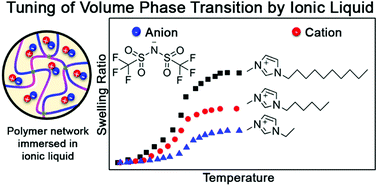Tuning of volume phase transition of ionogels based on the chemical structure of ionic liquids
Abstract
Ionogels are crosslinked polymeric networks swollen in ionic liquids (ILs) with coupled cation–anion structures. Notably, ionogels are promising candidates for a wide range of applications owing to their biocompatibility, high electrical conductivity, mechanical durability, and chemical stability. The thermal behavior of ionogels can be tuned based on the chemical structure of the polymer network. However, the modification of the swelling behavior and thermo-responsiveness depending on the properties of the IL for a given polymer network has been rarely reported. To better understand the thermal behavior of ionogels based on the chemical structure of the ILs, in this study, a series of poly(N-isopropylacrylamide-co-N,N′-diethylacrylamide) ionogels were prepared and swollen in various ILs and their mixtures. By measuring the temperature-dependent swelling ratio change of the prepared ionogels, it was revealed that the chemical structure of the IL is the major factor governing their swelling and thermal behavior. Variations in the cationic and/or anionic structures led to changes in the transition temperature range and degree of volume change upon heating; this was owing to variations in the interactions between the IL and the polymer network. Furthermore, the volume phase transition of the ionogels could be finely tuned by adjusting the composition of the medium, which was controlled by the mixing of ILs.



 Please wait while we load your content...
Please wait while we load your content...